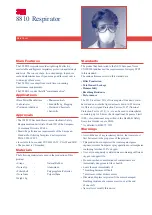
3.3 Inspection
1. Before each use and after cleaning (Section 3.2), inspect the individual parts and ensure that
all components and connection sites are clean and in good condition.
2. Inspect for damages such as holes, cracks, and scratches on all parts. If in doubt of effective
respiratory performance replace the parts with only
A
RC
O
NE
®
approved parts for this system.
3. Additionally, inspect the following:
a. Blower unit: Button function. Replace blower if damaged.
b. Breathing Tube:
• O-ring state. Replace if worn/cut, torn, or if in doubt as to condition.
• Check for holes or splitting. When in doubt, replace the Breathing Tube.
• NEVER patch the Breathing Tube.
c. Face Seal: ensure that the Face Seal has not lost its elasticity and that there are no tears
or holes. Replace if in doubt as to the condition of the Face Seal.
d. Waist Belt: ensure the clip securely snaps together.
Do not allow contaminants to enter into the breathing tube or blower
unit. Failure to prevent contaminants from entering into the
A
RC
O
NE
®
A
IR
P
LUS
®
PAPR system could lead to contaminant exposure
resulting in serious bodily injury or loss of life. Consult your local
safety professional in event contaminant entry into the breathing
tube or blower unit is suspected.
-16-
Do not clean the HE filter by any means including forced air. Doing
so will damage the filter and void the Blower Unit warranty.
Change the HE filter after 40 hours of use or when proper airflow
cannot be maintained.
PAPR
Do not allow water to enter into the blower unit or the battery pack.
Failure to prevent water from entering into the blower unit or battery
pack could cause the product to fail, leading to contaminant
exposure resulting in serious bodily injury or loss of life. Any filter,
which has been directly exposed to water, must be disposed of in
accordance with state, local, and federal ordinances.
Do not clean any part of the system with gasoline, organic based
solvents or chlorinated degreasing fluids (such as trichloroethylene).
Use of these substances could lead to contaminant exposure and/or
product failure resulting in serious injury or loss of life.

































